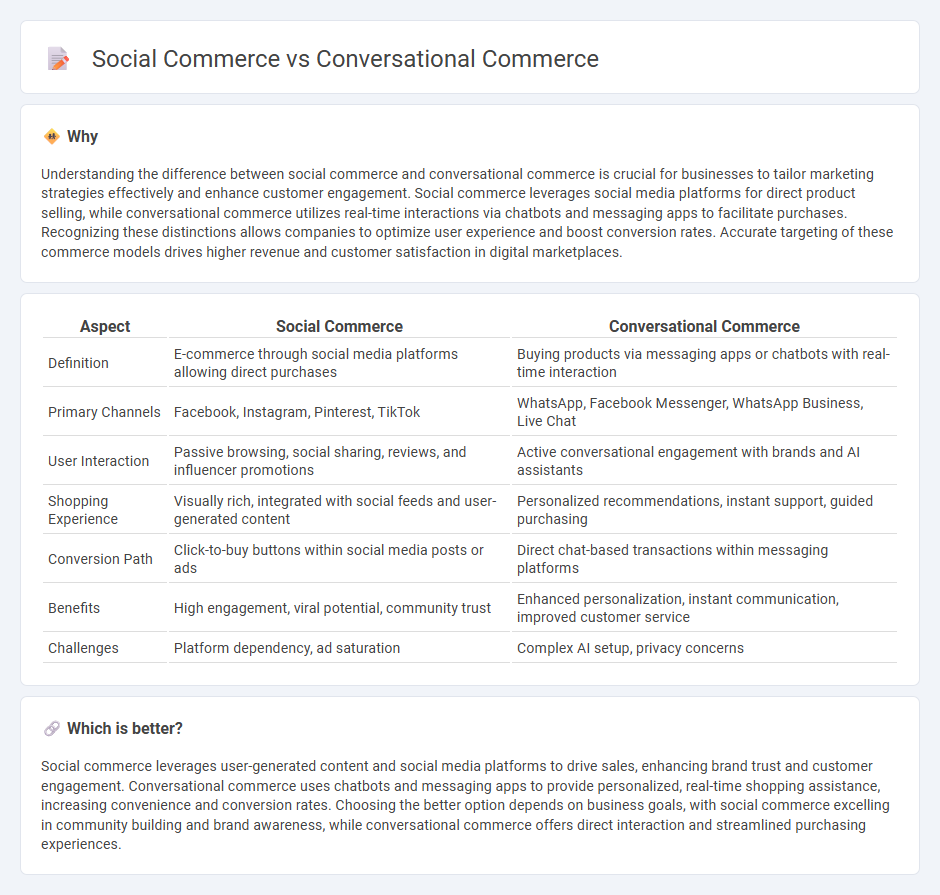
Social commerce integrates shopping experiences directly within social media platforms, leveraging user-generated content and social interactions to drive purchases. Conversational commerce uses chatbots and messaging apps to enable personalized, real-time customer engagement and transaction facilitation. Explore how these innovative commerce models transform digital retail dynamics.
Why it is important
Understanding the difference between social commerce and conversational commerce is crucial for businesses to tailor marketing strategies effectively and enhance customer engagement. Social commerce leverages social media platforms for direct product selling, while conversational commerce utilizes real-time interactions via chatbots and messaging apps to facilitate purchases. Recognizing these distinctions allows companies to optimize user experience and boost conversion rates. Accurate targeting of these commerce models drives higher revenue and customer satisfaction in digital marketplaces.
Comparison Table
| Aspect | Social Commerce | Conversational Commerce |
|---|---|---|
| Definition | E-commerce through social media platforms allowing direct purchases | Buying products via messaging apps or chatbots with real-time interaction |
| Primary Channels | Facebook, Instagram, Pinterest, TikTok | WhatsApp, Facebook Messenger, WhatsApp Business, Live Chat |
| User Interaction | Passive browsing, social sharing, reviews, and influencer promotions | Active conversational engagement with brands and AI assistants |
| Shopping Experience | Visually rich, integrated with social feeds and user-generated content | Personalized recommendations, instant support, guided purchasing |
| Conversion Path | Click-to-buy buttons within social media posts or ads | Direct chat-based transactions within messaging platforms |
| Benefits | High engagement, viral potential, community trust | Enhanced personalization, instant communication, improved customer service |
| Challenges | Platform dependency, ad saturation | Complex AI setup, privacy concerns |
Which is better?
Social commerce leverages user-generated content and social media platforms to drive sales, enhancing brand trust and customer engagement. Conversational commerce uses chatbots and messaging apps to provide personalized, real-time shopping assistance, increasing convenience and conversion rates. Choosing the better option depends on business goals, with social commerce excelling in community building and brand awareness, while conversational commerce offers direct interaction and streamlined purchasing experiences.
Connection
Social commerce integrates e-commerce into social media platforms, enabling users to discover and purchase products seamlessly within their social networks. Conversational commerce leverages messaging apps and chatbots to provide personalized shopping experiences and real-time customer support. Together, they create an interactive, engaging shopping environment that drives higher conversion rates and enhances customer satisfaction.
Key Terms
Conversational Commerce:
Conversational commerce leverages real-time messaging platforms like chatbots and AI-driven assistants to enhance customer interactions and streamline purchasing processes. It enables personalized shopping experiences through direct, instant communication on apps such as WhatsApp, Facebook Messenger, and website live chats. Explore the transformative impact of conversational commerce on modern retail efficiency and customer engagement.
Chatbots
Conversational commerce centers on using AI-driven chatbots to engage customers through personalized interactions, facilitating seamless purchasing within messaging apps. Social commerce integrates shopping experiences directly into social media platforms, enhancing brand exposure and leveraging peer reviews and influencer marketing, often supported by chatbot features for real-time customer assistance. Discover how chatbots revolutionize both conversational and social commerce, driving higher engagement and sales conversions.
Messaging Apps
Conversational commerce leverages messaging apps like WhatsApp, Facebook Messenger, and WeChat to facilitate real-time customer interactions, personalized recommendations, and seamless in-app purchases. Social commerce centers on shopping experiences directly within social media platforms such as Instagram, Facebook, and TikTok, where users discover and buy products through posts, stories, and ads. Explore the differences in how messaging apps transform conversational commerce for enhanced customer engagement.
Source and External Links
What is conversational commerce? Examples, types, + benefits - Conversational commerce refers to e-commerce brands using messaging and conversational technologies like chatbots and messaging apps to enhance the shopping experience through real-time, personalized communication that influences purchase decisions.
What Is Conversational Commerce? Definition and Guide - Shopify - Conversational commerce uses chatbots, messaging apps, and voice assistants to facilitate online shopping by enabling customers to interact with brands for recommendations, purchases, and support within familiar messaging platforms.
What Is Conversational Commerce? | Salesforce US - Conversational commerce is the use of messaging apps, chatbots, and voice assistants to provide smooth, personalized customer interactions and transactions that feel organic, increasing sales and fostering loyalty.
 dowidth.com
dowidth.com